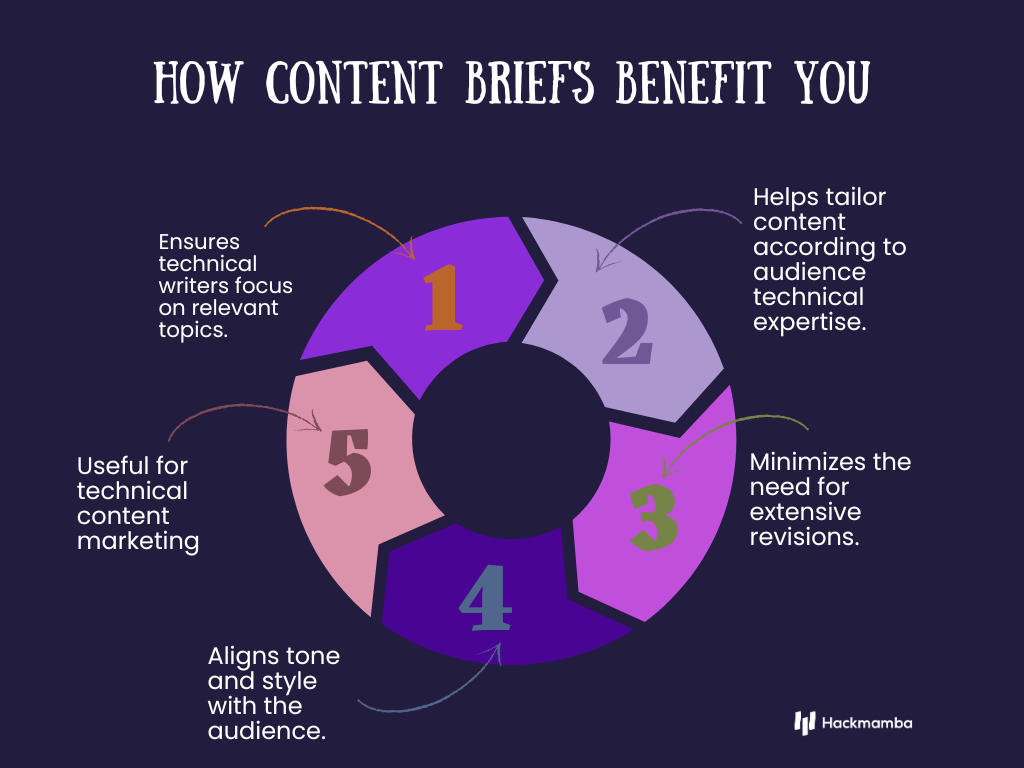![A guide to creating a content brief for technical writers [+template]](https://cdn.sanity.io/images/5fynpi9j/production/267616a47e62bac837cb63468287f260baab276b-1920x1080.png?rect=0,60,1920,960&w=700&h=350&auto=format)

Henry Bassey
6 min readJul 22 2024
A guide to creating a content brief for technical writers [+template]
Any technical or marketing content is only as good as the content brief and outline that guide it. As a technical content marketing agency, we know this for sure. Even the most skilled technical writer will struggle to produce effective content without a good brief.
This is because creating quality content involves integrating various elements, such as understanding the target audience, knowing the key objectives, adhering to the brand voice, and ensuring accuracy and coherence in the information presented.
A content brief sets the stage for a content outline. Detailed content briefs and content outlines are the tools that help you set expectations before handing them over to your writer.
As a content manager, editor, or project manager, you'll need content briefs to assign tasks to your content team and ensure that written content aligns with the overall content marketing strategy. This guide will cover the necessary bits and pieces to create detailed technical and SEO-focused content briefs.
We'll pick and develop one topic as we progress through the different steps to demonstrate how it works. You'll also receive a free content brief template at the end of the article.
Don't confuse a content brief and a content outline.
Both brief and outline are two important documents in content creation. A content brief provides a high-level overview of the content you want to create for your blog post. It sets the direction for the technical writer and ensures everyone is on the same page.
The brief acts as a roadmap, providing direction and focus. It outlines the purpose of the content, the specific topics to be covered, and the desired outcomes. This ensures that the writer can tailor the content to meet the audience's particular needs, addressing their pain points and answering their questions.
Creating content briefs lays the groundwork by clearly defining the project's scope, the key messages to be communicated, and the tone and style that should be used to align with the content strategy.
It answers questions such as - Who is the target audience? What are their main concerns and interests? What action should the reader take after consuming the content? By addressing these questions, the brief ensures that the writer understands the project's goals and requirements.
Once the brief is in place, it naturally leads to creating a content outline. The outline builds on the brief by breaking down the content into manageable sections, highlighting the main points and subpoints to be discussed.
This structure helps the writer maintain a logical flow and ensures no critical information is overlooked. It allows for a more efficient writing process, where the writer can concentrate on developing each section with clarity and depth.
How does content brief benefit you and your technical writers?
A content brief helps you streamline workflows, clarifies expectations, reduces revisions, and, most importantly, helps create content that resonates with your readers.

1. Streamlines workflows
Suppose you have a topic on "CI/CD Pipeline Implementation," Without a brief, a technical writer might start writing the tutorial immediately. This could lead to researching features and functionalities that might not be relevant to the audience. It can result in wasted effort and missed deadlines.
A content brief outlining the goal (e.g., "Guide developers with a step-by-step guide to building a basic CI/CD pipeline for a simple microservices application using a popular tool (e.g., Jenkins)") optimizes the process. The writer knows exactly what to focus on and can begin writing relevant content quickly.
2. Clarifies expectations
Without a content brief, there may be ambiguity about the required level of technical detail. The writer may produce a highly detailed guide assuming advanced knowledge, while the audience may be beginners or in a different phase of the customer journey. This mismatch could result in confusion, frustration, and missed opportunities.
A content brief helps by specifying the technical expertise of the audience (e.g., "Novice developers with limited experience in DevOps principles and CI/CD pipelines"). This clarification sets clear expectations and ensures that the writer tailors the content to the appropriate level of understanding.
3. Reduces revisions
Not having a brief before writing the tutorial may require the writer to make extensive revisions later if the content does not meet the client's needs or align with the consumer, leading to delays and frustration.
However, with a brief, the writer can outline the desired content (e.g., specific code examples, troubleshooting tips) and the tone (e.g., conversational, step-by-step) upfront. This minimizes the need for revisions as the writer has a clear roadmap from the beginning.
4. Creates content that resonates.
Without a brief, the tone and style could become too technical or formal for the intended audience, making the content dull and uninteresting. However, with a brief, the desired style and tone are clearly outlined, ensuring that the writer produces content that resonates with the audience and keeps them engaged and more likely to follow the tutorial.
5. Necessary for technical marketing content.
Content briefs can be especially valuable for technical marketing content. Technical writers are experts at conveying complex information, but marketing content often requires a different approach, focusing on persuasive language and audience engagement.
A content brief provides the technical writer with a good understanding of the marketing goals, audience, and desired tone.
How to create a content brief for technical and SEO content
These are the steps to creating an outstanding technical and SEO content brief:
1. Start with a goal/outcome
The foundation of a strong content brief is a clear goal or outcome. The goal will shape the article's general architecture/layout and flow, including the Call-To-Action (CTA).
Defining what you want to achieve with the content guides you in creating the content outline later and helps the writer approach the topic with a specific user journey in mind. The beginning and end of the piece should directly support this goal.
Thinking about a user journey can be helpful. Using our example of "CI/CD Pipeline Implementation" and the goal to "Equip developers with a step-by-step guide to building a basic CI/CD pipeline for a simple microservices application using a popular tool (Jenkins)," the content would follow a logical progression for the user:
-
Start: Introduce the concept of CI/CD pipelines, their benefits for microservices development, and the problems the user is facing.
-
Middle: Explain the step-by-step process of building a basic CI/CD pipeline using the chosen tool, with clear instructions and code examples (e.g., setting up the build server, integrating with version control, automating tests and deployment).
-
End: Offer troubleshooting tips and best practices for maintaining and optimizing the CI/CD pipeline.
This approach ensures the content addresses the user's knowledge level at each stage, leading them smoothly toward achieving the goal (building a basic CI/CD pipeline).
2. Know your target audience.
The second step in creating an outstanding content brief is identifying and understanding your target audience. Knowing who you're writing for will shape your content's tone, complexity, and overall direction on the CI/CD pipeline tutorial. Here are some key questions to consider:
Technical background
What's their experience level with software development and DevOps principles? Are they new to CI/CD concepts and require fundamental explanations (Novice developers)? Are they familiar with development workflows but may need guidance on implementing CI/CD pipelines (Experienced engineers)? Are they seeking to refine their existing CI/CD practices or learn about specific tools and configurations (DevOps professionals)?
Project stage
Are they just learning about CI/CD and its benefits for microservices development (Exploration phase)? Are they ready to set up their first CI/CD pipeline for a simple application (Implementation stage)? Are they looking to troubleshoot or improve an existing CI/CD pipeline (Optimization stage)?
Pain points
What are their challenges related to software development and deployment? Why does this matter (what will they lose if they don't find the solution)? What's the magnitude of this problem (check statistics!) How is your solution going to be better than what is already obtainable? Understanding these factors helps tailor your content to resonate with the audience's needs.
Finding your audience insights
Here are some methods to better understand your target audience:
-
Search Engine Results Page (SERP) analysis: Analyze the top-ranking articles for the target keywords, e.g., "CI/CD Pipeline" and related keywords. Look at the content type (articles, videos, tutorials) and what topics are emphasized.
-
SERP features: Pay attention to the existing search results page features like featured snippets, videos, and images. These highlight what formats and information users find most helpful.
-
People Also Ask (PAA) sections: These questions reveal common concerns and knowledge gaps users have about CI/CD pipelines.
-
Knowledge panels: Review the key facts and entities displayed in knowledge panels for "CI/CD Pipeline." This can offer clues about user interests related to the topic.
-
Social media listening: Monitor relevant Twitter, Reddit, and developer forum conversations. See what questions and challenges developers are discussing regarding CI/CD pipelines.
With this thorough audience research, you can write a CI/CD pipeline tutorial that educates, engages, and guides your readers effectively. We cover these tactics in depth in our article on creating engaging developer content.

3. What keyword are you targeting?
The target keyword is the primary phrase or term you want your content to rank for on the search results page. It summarizes the core topic you're writing about.
You'll need to use a keyword research tool to identify your primary and secondary keywords to gather information. With SEO tools, you can look for the monthly search volume to understand the importance of the topic, keyword difficulty to assess competition, and trends to see how interest fluctuates over time.
For example, our primary keyword, "CI/CD Pipeline," has a search volume of over 46K and a difficulty of 67%.
We use SEMrush for our keyword research, but you can use any tool. The primary keyword will help you analyze competitor articles and inform their placement in your title, content, and meta description.
4. Understand the intent behind the keyword.
Just like people, keywords have intentions. Intent helps you uncover the user's underlying motive for searching. Understanding the search intent behind your target keyword also feeds into your marketing funnel by helping you cater content to users at different stages of their buying journey (awareness, consideration, decision, and action).
There are four main categories of search intent:
-
Informational: Users seek information and want to learn about a topic. This aligns with our "CI/CD Pipeline" example, as users are most likely searching to understand the concept and how it works.
-
Navigational: Users are looking for a specific website or webpage. They already know where they want to go and use keywords to find it quickly.
-
Commercial: Users are in the research phase of their buying journey. They're interested in learning about products or services related to a specific need, comparing options, and reading reviews.
-
Transactional: Users are ready to make a purchase. They use keywords to find specific products or services and complete a transaction.
Understanding the search intent behind your target keyword can help tailor your content to meet the user's needs. For our "CI/CD Pipeline Implementation" topic, with an informational intent and awareness stage, you'd create a tutorial or guide explaining the concept, its benefits, and step-by-step implementation.
5. Conduct gap/opportunity analysis:
Is there a different angle, a missing step, or unanswered questions? This "gap analysis" helps you write content that stands out by offering unique information readers won't find elsewhere.
Always keep "information gain" in mind when conducting your analysis. Providing additional information not found in other articles adds more value for the reader. Gap analysis is important for creating titles, as it allows you to adjust to address any missing information and generate more interest in your article. Read our approach to creating differentiated SEO content.
6. Researching an exciting and captivating title
I previously mentioned how a piece of content is as good as the content brief, but the title plays a massive role in its success. A strong title sparks excitement and curiosity, drawing the content writer deeper into the content and enticing the reader to explore further.
However, a dull title can lead to a "sweet struggle" for the writer by hindering his curiosity and creative flow. A curious mind writes the best content. A genuinely interested writer will naturally uncover fascinating aspects to share, and the title can help spark that initial curiosity.
Creating a compelling title requires both creativity and strategic thinking. It must be concise enough to grab attention yet descriptive enough to inform readers about the content. Additionally, SEO optimization is essential to ensure the content is discoverable in search engines.
Take our "CI/CD Pipeline Implementation" topic as an example. While informative, it doesn't pique immediate interest. A captivating title could be:
- Build a CI/CD Pipeline for Microservices in Minutes (Highlights ease of use)
- A Step-by-Step Guide to CI/CD Pipeline for Complete Beginners (Focuses on user journey and target audience)
These examples demonstrate how a well-crafted title can make the topic more enjoyable for the content writer and the reader. By investing time in creating a captivating title, you set the stage for a successful content creation process, driving both writer engagement to produce high-quality content and reader interest.
Don't be afraid to experiment with different titles, considering your target audience and the overall content tone. Testing and analyzing reader engagement can help refine your title selection for maximum impact.
7. Add the target word count.
A word count provides a framework for the level of detail required. They ensure your content hits the target length for user engagement. Think of it as finding the sweet spot – too short, and you leave readers hanging; too long, and they get lost in the weeds.
You can investigate existing content ranking for your topic to get a sense of optimal length. Analyze these top articles to know how many words they use. This competitive analysis can provide valuable insights to guide your approach and help you determine the ideal word count to deliver your content.
8. Include resources for linking opportunities.
External writers may not be as familiar with your existing content related to the topic. Provide internal linking resources within your content brief to guide writers towards relevant content on your site that can be referenced, benefiting both search engines and readers seeking further information on related topics.
Here's how to break it down:
- Internal links: List existing blog posts, articles, or website resources relevant to the topic. Using our CI/CD pipelines and DevOps principles examples, other resources could include:
- "Benefits of Implementing a CI/CD Pipeline for Microservices,"
- "Getting Started with Version Control for Developers" and;
- "Troubleshooting Common CI/CD Pipeline Issues."
Briefly describe each resource to explain its connection to the current content. Use anchor text strategically, choosing descriptive phrases that indicate the linked content's relevance.
- External links: While internal linking is prioritized, you can include a limited list of highly reputable external resources that offer valuable supplementary information.
Focus on authoritative sources such as:
- Official documentation for popular CI/CD tools (e.g., Jenkins docs)
- Industry publications like The CI/CD Report or DevOps.com and academic journals with relevant research on CI/CD practices.
- Briefly justify each external link, explaining its relevance to the topic.
9. Define your CTA
Clearly outline your content brief's desired Call to Action (CTA) to ensure a compelling conclusion and guide reader action. This could be prompting readers to download a whitepaper, subscribing to a newsletter, or exploring a related product offering. A well-defined CTA empowers writers to build a natural, effective ending that leaves a lasting impression and drives user engagement.
10. Link to your Content outline and style guide
Finally, include links to your content outline and style guide at the end of your content brief. These resources provide writers with a roadmap for the content structure and your specific formatting preferences. Having them readily available ensures the writer stays on track and delivers content that aligns with your brand voice and formatting standards.
Content brief template for technical writers
Here's your free content brief template to help you create content briefs. Also, read our elaborate guide on creating content outlines that make a difference!

About the author
Henry Bassey spearheads Content Strategy and Marketing Operations at Hackmamba. He holds an MBA from the prestigious Quantic School of Business and Technology with a solid technical background. A strong advocate for innovation and thought leadership, his commitment permeates every content he handles for clients at Hackmamba.
More articles


Akshat Virmani
6 min readSep 15 2024
Leading Low-Code Documentation Tools for Technical Writers
Discover the top 6 low-code documentation tools that simplify the documentation process for technical writers. Learn about key features, benefits, and challenges.
Read Blog


Akshat Virmani
6 min readAug 31 2024
Pros and Cons of Serverless Computing
Understand the pros and cons of serverless computing, from cost savings and scalability to vendor lock-in and cold start delays. Find out if it's right for your app.
Read Blog


Henry Bassey
6 min readAug 06 2024
Steps to creating an outstanding content outline for Technical Writers
Transform your technical writing with a solid content outline. Follow our detailed guide to create structured, informative, and engaging content.
Read Blog
